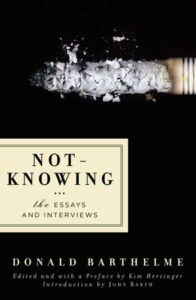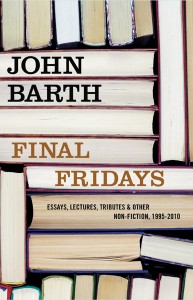John Barth
John Barth grew up in Cambridge, Maryland, and attended Johns Hopkins University before writing his celebrated first novel The Floating Opera in 1956. Since then he has produced more than fifteen of collections of short stories, essays, and novels that have won prestigious accolades, including the National Book Award and the F. Scott Fitzgerald Award. He divides his time between Maryland and Florida.
Subscribe to our newsletter for news & events from Counterpoint Press.
Books
Not-Knowing
The Essays and Interviews
The wildly varied essays in Not–Knowing combine to form a posthumous manifesto of one of America's masters of literary experiment. Here are Barthelme's thoughts on writing (his own and others); his observations on art, architecture, film, and city life; interviews, including two previously unpublished; and meditations on everything from Superman III to the art of rendering "Melancholy Baby" on jazz banjolele. This is a rich and eclectic selection of work by the man Robert Coover has called "one of the great citizens of contemporary world letters."Final Fridays
For decades, acclaimed author John Barth has strayed from his Monday–through–Thursday–morning routine of fiction–writing and dedicated Friday mornings to the muse of nonfiction. The result is Final Fridays, his third essay collection, following The Friday Book (1984) and Further Fridays (1995). Sixteen years and six novels since his last volume of non–fiction, Barth delivers yet another remarkable work comprised of 27 insightful essays.With pieces covering everything from reading, writing, and the state of the art, to tributes to writer–friends and family members, this collection is witty and engaging throughout. Barth's "unaffected love of learning" (San Francisco Examiner & Chronicle) and "joy in thinking that becomes contagious" (Washington Post), shine through in this third, and, with an implied question mark, final essay collection.
Every Third Thought
A Novel in Five Seasons
John Barth stays true to form in Every Third Thought, written from the perspective of a character Barth introduced in his short story collection The Development.George I. Newett and his wife Amanda Todd lived in the gated community of Heron Bay Estates until its destruction by a fluke tornado. This event, Newett notes, occurred on the 77th anniversary of the 1929 stock market crash, a detail that would appear insignificant if it were not for several subsequent events.
The stress of the tornado's devastation prompts the Newett–Todds to depart on a European vacation, during which George suffers a fall on none other than his 77th birthday, the first day of autumn (or more cryptically, fall). Following this coincidence, George experiences the first of what is to become five serial visions, each appearing to him on the first day of the ensuing seasons, and each corresponding to a pivotal event in that season of his life.
As the novel unfolds, so do these uncanny coincidences, and it is clear that, as ever, Barth possesses an unmatched talent in balancing his characteristic style and wit with vivid, page–turning storytelling.

Catapult | Counterpoint | Soft Skull
20 Jay Street #704
Brooklyn, NY 11201
646.926.0805 | contact@catapult.co







